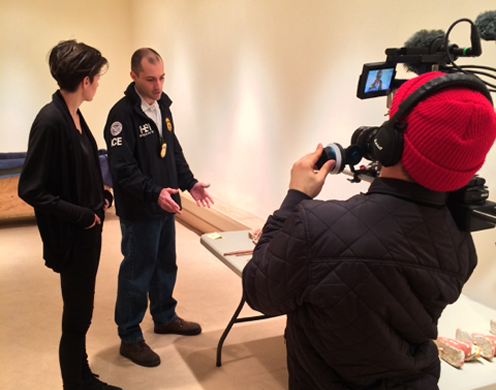ICE special agent discusses art smuggling at Baylor University law school
On Wednesday, April 15, U.S. Immigration and Customs Enforcement's (ICE) Homeland Security Investigations (HSI) Senior Special Agent Brent Easter traveled to Waco, Texas to discuss art smuggling at Baylor University Law School.
Easter gave a three-part presentation entitled "Catching Art Thieves and Dismantling Smuggling Networks." He spoke to more than 200 students and administrators, sharing with them some of his adjudicated cases, and how he and his colleagues detect smuggling networks, identify and return stolen art. Easter was invited to speak by Dr. Nathan Elkins, an assistant professor of art history at Baylor who has worked with HSI on several antiques trafficking and smuggling cases, helping the agency identify smuggled coins from Bulgaria, Italy and Romania.
"It was great. I was happy to do it," Easter said. "In the last few months a lot of people have become interested [in art smuggling] so I've been asked to do a lot of media. The students at Baylor were very engaging."
The passion Easter shared with students didn't just start when he joined ICE's Homeland Security Investigations. Growing up, Easter always wanted to be a real-life Indiana Jones, so much so that every Halloween that he can remember, he's dressed up as the legendary Dr. Henry Jones. He grew up watching every movie, from Raiders of the Lost Ark to Temple of Doom. When it came time to pick a major, the choice was easy – he decided to study anthropology and archaeology, at Brandeis University in Waltham, Massachusetts
Based in New York, Easter joined the federal government in 2002 with U.S. Border Patrol and has been with ICE HSI since 2004. As his career progressed, that Indiana Jones persona has become a reality for Easter. Every day he's able to do what he loves — investigate crimes involving cultural property, art and antiquities and then work with experts to authenticate the items, determine their true ownership and return them to their countries of origin.
Easter discussed a wide range of topics including how to identify smuggled artifacts, the value of stolen coins and the challenges that law enforcement faces when investigating these crimes. Many students stayed after the lecture to ask questions and many showed interested in the process needed to take to become a special agent.
As someone who, when he was in college was inspired by those in law enforcement and who didn't know where he wanted his career path to take him, the lecture was nostalgic for Easter. It also served as motivation to continue fighting to combat smuggling.
"Each operation we try to build upon," Easter said. "We have to continue to improve our intelligence and sources. As we do, we become better at breaking down these networks and combating cultural property crime."
Since 2007, more than 7,800 artifacts have been returned to over 30 countries including paintings from France, Germany, Poland and Austria, 15th-18th century manuscripts from Italy and Peru, cultural artifacts from China, Cambodia and Iraq, two Baatar dinosaur fossils to Mongolia and most recently 19 antiquities were returned to Italy.
Learn more about HSI's cultural property, art and antiquities investigations. Members of the public who have information about suspected stolen cultural property are urged to call the toll-free tip line at 1-866-DHS-2-ICE or to complete the online tip form.




